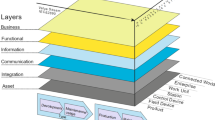Abstract
This chapter gathers a number of reviews that offer an open, scientific discussion on the transition from PROSA, the well-known reference architecture for Holonic Manufacturing Systems proposed twenty years ago by the School of Leuven, Belgium, to ARTI – the new reference model for IT-based general-purpose control systems proposed by Paul Valckenaers, that stimulates a higher level of abstraction and genericity in understanding and inferring reality. ARTI models architecture elements of reality as intelligent beings in a dominant position relative to their related decision-making components modelled as intelligent agents. The reviews start with overviews of the creation process, the structural elements - holon classes and the features - aggregation, specialization, abstraction levels, flexibility and scalability. The needs that led to the evolution of PROSA into ARTI are analysed: the difficulties to spread the architecture in the research community and industry, the lack of suitability to act as reference architecture for Cyber-Physical Production Systems and Industrial Internet of Things framework in the Industry 4.0 vision of future manufacturing. The reviews discuss the elements and coverage of ARTI, and the translation of basic and staff PROSA holons into new abstract categories: intelligent beings-agents, types-instances, and resources-activities. It is appreciated that, beyond the problem of terminology of PROSA holons difficult to apply in other domains than manufacturing, the move to ARTI assures in-depth interoperability, access to the world-of-interest through digital twins that interact with smart control systems influencing thus these intelligent beings (e.g., plant, shop floor, healthcare system, environment facility, supply chain, service system) into the desired behaviours. From the software implementing point of view, most of the reviewers agreed on the fact that none of the programming languages except for Erlang provided acceptable levels of viability and sustainability for PROSA application classes. An interesting point of view is formulated about the possibility to use ARTI for Enterprise Integration and Interoperability. The present discussions appreciates the new ARTI reference architecture together with D-MAS pattern as an enhanced model to build flexible, intelligent and robust control systems based on prioritizing situation awareness and real-world interoperability. This scientific discussion about the new ARTI model, initiated, presented and critically analysed for the first time in the SOHOMA scientific community needs to be continued by the research community for enrichment and industry adoption.
Access this chapter
Tax calculation will be finalised at checkout
Purchases are for personal use only
Similar content being viewed by others
References
Youssef, J.R., Zacharewicz, G., Chen, D.: Developing an Enterprise Operating System (EOS)-requirements and architecture. In: 2016 IEEE 25th International Conference on Enabling Technologies: Infrastructure for Collaborative Enterprises (WETICE), pp. 130–135. IEEE (2016)
Ducq, Y., Chen, D., Doumeingts, G.: A contribution of system theory to sustainable enterprise interoperability science base. Comput. Ind. 63(8), 844–857 (2012)
Weichhart, G., Stary, C., Vernadat, F.: Enterprise modelling for interoperable and knowledge-based enterprises. Int. J. Prod. Res. 56(8), 2818–2840 (2018)
Weichhart, G., Molina, A., Chen, D., Whitman, L.E., Vernadat, F.: Challenges and current developments for sensing, smart and sustainable enterprise systems. Comput. Ind. 79, 34–46 (2016)
Author information
Authors and Affiliations
Corresponding author
Editor information
Editors and Affiliations
Rights and permissions
Copyright information
© 2019 Springer Nature Switzerland AG
About this paper
Cite this paper
Borangiu, T. et al. (2019). Scientific Discussion: Open Reviews of “ARTI Reference Architecture – PROSA Revisited”. In: Borangiu, T., Trentesaux, D., Thomas, A., Cavalieri, S. (eds) Service Orientation in Holonic and Multi-Agent Manufacturing. SOHOMA 2018. Studies in Computational Intelligence, vol 803. Springer, Cham. https://doi.org/10.1007/978-3-030-03003-2_2
Download citation
DOI: https://doi.org/10.1007/978-3-030-03003-2_2
Published:
Publisher Name: Springer, Cham
Print ISBN: 978-3-030-03002-5
Online ISBN: 978-3-030-03003-2
eBook Packages: Intelligent Technologies and RoboticsIntelligent Technologies and Robotics (R0)




